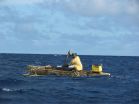Since that landmark discovery, more than 1900 exoplanets in 1200 planetary systems have been confirmed, but, in the year of the twentieth anniversary of its discovery, 51 Pegasi b returns to the ring once more to provide another advance in exoplanet studies.
The team that made this new detection was led by Jorge Martins from the Instituto de Astrofísica e Ciências do Espaço (IA) and the Universidade do Porto, Portugal, who is currently a PhD student at ESO in Chile. They used the HARPS instrument on the ESO 3.6-metre telescope at the La Silla Observatory in Chile.
Currently, the most widely used method to examine an exoplanet's atmosphere is to observe the host star's spectrum as it is filtered through the planet's atmosphere during transit -- a technique known as transmission spectroscopy. An alternative approach is to observe the system when the star passes in front of the planet, which primarily provides information about the exoplanet's temperature.
The new technique does not depend on finding a planetary transit, and so can potentially be used to study many more exoplanets. It allows the planetary spectrum to be directly detected in visible light, which means that different characteristics of the planet that are inaccessible to other techniques can be inferred.
The host star's spectrum is used as a template to guide a search for a similar signature of light that is expected to be reflected off the planet as it describes its orbit. This is an exceedingly difficult task as planets are incredibly dim in comparison to their dazzling parent stars.
The signal from the planet is also easily swamped by other tiny effects and sources of noise [3]. In the face of such adversity, the success of the technique when applied to the HARPS data collected on 51 Pegasi b provides an extremely valuable proof of concept.
Jorge Martins explains: "This type of detection technique is of great scientific importance, as it allows us to measure the planet's realmass and orbital inclination, which is essential to more fully understand the system. It also allows us to estimate the planet's reflectivity, or albedo, which can be used to infer the composition of both the planet's surface and atmosphere."
51 Pegasi b was found to have a mass about half that of Jupiter's and an orbit with an inclination of about nine degrees to the direction to the Earth [4]. The planet also seems to be larger than Jupiter in diameter and to be highly reflective. These are typical properties for a hot Jupiter that is very close to its parent star and exposed to intense starlight.
HARPS was essential to the team's work, but the fact that the result was obtained using the ESO 3.6-metre telescope, which has a limited range of application with this technique, is exciting news for astronomers. Existing equipment like this will be surpassed by much more advanced instruments on larger telescopes, such as ESO's Very Large Telescope and the future European Extremely Large Telescope [5].
"We are now eagerly awaiting first light of the ESPRESSO spectrograph on the VLT so that we can do more detailed studies of this and other planetary systems," concludes Nuno Santos, of the IA and Universidade do Porto, who is a co-author of the new paper.
INFORMATION:
Notes
[1] Both 51 Pegasi b and its host star 51 Pegasi are among the objects available for public naming in the IAU's NameExoWorlds contest.
[2] Two earlier planetary objects were detected orbiting in the extreme environment of a pulsar.
[3] The challenge is similar to trying to study the faint glimmer reflected off a tiny insect flying around a distant and brilliant light.
[4] This means that the planet's orbit is close to being edge on asseen from Earth, although this is not close enough for transits to take place.
[5] ESPRESSO on the VLT, and later even more powerful instruments on much larger telescopes such as the E-ELT, will allow for a significant increase in precision and collecting power, aiding the detection of smaller exoplanets, while providing an increase in detail in the data for planets similar to 51 Pegasi b.
More information
This research was presented in a paper "Evidence for a spectroscopic direct detection of reflected light from 51 Peg b", by J. Martins et al., to appear in the journal Astronomy & Astrophysics on 22 April 2015.
The team is composed of J. H. C. Martins (IA and Universidade do Porto, Porto, Portugal; ESO, Santiago, Chile), N. C. Santos (IA and Universidade do Porto), P. Figueira (IA and Universidade do Porto), J. P. Faria (IA and Universidade do Porto), M. Montalto (IA and Universidade do Porto), I. Boisse (Aix Marseille Université, Marseille, France), D. Ehrenreich (Observatoire de Genève, Geneva, Switzerland), C. Lovis (Observatoire de Genève), M. Mayor (Observatoire de Genève), C. Melo (ESO, Santiago, Chile), F. Pepe (Observatoire de Genève), S. G. Sousa (IA and Universidade do Porto), S. Udry (Observatoire de Genève) and D. Cunha (IA and Universidade do Porto).
ESO is the foremost intergovernmental astronomy organisation in Europe and the world's most productive ground-based astronomical observatory by far. It is supported by 16 countries: Austria, Belgium, Brazil, the Czech Republic, Denmark, France, Finland, Germany, Italy, the Netherlands, Poland, Portugal, Spain, Sweden, Switzerland and the United Kingdom, along with the host state of Chile. ESO carries out an ambitious programme focused on the design, construction and operation of powerful ground-based observing facilities enabling astronomers to make important scientific discoveries. ESO also plays a leading role in promoting and organising cooperation in astronomical research. ESO operates three unique world-class observing sites in Chile: La Silla, Paranal and Chajnantor. At Paranal, ESO operates the Very Large Telescope, the world's most advanced visible-light astronomical observatory and two survey telescopes. VISTA works in the infrared and is the world's largest survey telescope and the VLT Survey Telescope is the largest telescope designed to exclusively survey the skies in visible light. ESO is a major partner in ALMA, the largest astronomical project in existence. And on Cerro Armazones, close to Paranal, ESO is building the 39-metre European Extremely Large Telescope, the E-ELT, which will become "the world's biggest eye on the sky".
Links
* Research paper: http://www.eso.org/public/archives/releases/sciencepapers/eso1517/eso1517a.pdf
* Photos of La Silla: http://www.eso.org/public/images/archive/category/lasilla/
Contacts
Jorge Martins
Instituto de Astrofísica e Ciências do Espaço/Universidade do Porto
Porto, Portugal
Tel: +56 2 2463 3087
Email: Jorge.Martins@iastro.pt
Nuno Santos
Instituto de Astrofísica e Ciências do Espaço/Universidade do Porto
Porto, Portugal
Tel: +351 226 089 893
Email: Nuno.Santos@iastro.pt
Stéphane Udry
Observatoire de l'Université de Genève
Geneva, Switzerland
Tel: +41 22 379 24 67
Email: stephane.udry@unige.ch
Isabelle Boisse
Aix Marseille Université
Marseille, France
Email: Isabelle.Boisse@lam.fr
Richard Hook
ESO Public Information Officer
Garching, Germany
Tel: +49 89 3200 6655
Cell: +49 151 1537 3591
Email: rhook@eso.org


